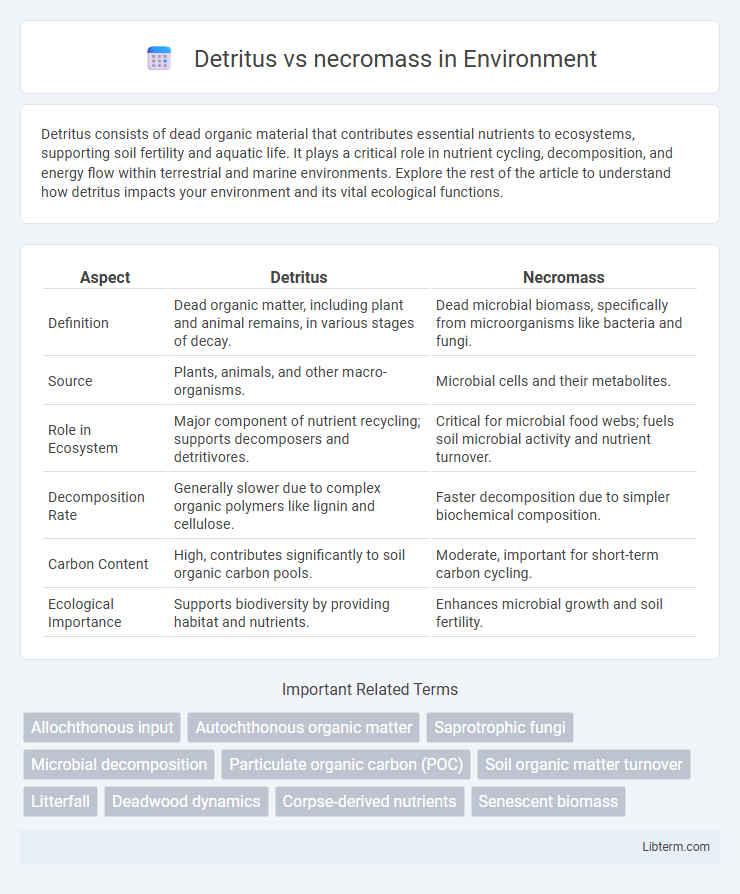Detritus consists of dead organic material that contributes essential nutrients to ecosystems, supporting soil fertility and aquatic life. It plays a critical role in nutrient cycling, decomposition, and energy flow within terrestrial and marine environments. Explore the rest of the article to understand how detritus impacts your environment and its vital ecological functions.
Table of Comparison
| Aspect | Detritus | Necromass |
|---|---|---|
| Definition | Dead organic matter, including plant and animal remains, in various stages of decay. | Dead microbial biomass, specifically from microorganisms like bacteria and fungi. |
| Source | Plants, animals, and other macro-organisms. | Microbial cells and their metabolites. |
| Role in Ecosystem | Major component of nutrient recycling; supports decomposers and detritivores. | Critical for microbial food webs; fuels soil microbial activity and nutrient turnover. |
| Decomposition Rate | Generally slower due to complex organic polymers like lignin and cellulose. | Faster decomposition due to simpler biochemical composition. |
| Carbon Content | High, contributes significantly to soil organic carbon pools. | Moderate, important for short-term carbon cycling. |
| Ecological Importance | Supports biodiversity by providing habitat and nutrients. | Enhances microbial growth and soil fertility. |
Introduction to Detritus and Necromass
Detritus consists of non-living organic matter such as dead plant and animal fragments that serve as a primary energy source in ecosystems. Necromass specifically refers to the biomass derived from recently deceased microbial cells, playing a crucial role in nutrient cycling and microbial food webs. Understanding the differences between detritus and necromass is essential for studying decomposition processes and ecosystem functioning.
Defining Detritus: What Is It?
Detritus consists of non-living organic matter, including decomposed plant and animal material, that accumulates in ecosystems as a key source of nutrients for soil microbes and detritivores. It differs from necromass, which specifically refers to the dead biomass of microorganisms such as bacteria and fungi, playing a crucial role in nutrient cycling at a microbial level. Understanding detritus involves recognizing its role as a foundational component in ecological food webs and biogeochemical processes.
Understanding Necromass: An Overview
Necromass refers specifically to the organic material derived from dead microbial cells, playing a crucial role in nutrient cycling within ecosystems. Unlike detritus, which includes a broader range of decomposing organic matter such as plant litter and animal remains, necromass is primarily microbial in origin and significantly influences soil microbial community dynamics. Understanding necromass enhances insights into carbon sequestration processes and microbial-driven decomposition in both terrestrial and aquatic environments.
Key Differences Between Detritus and Necromass
Detritus refers to non-living organic material derived from decomposed plants and animals, including leaves, wood, and fecal matter, whereas necromass specifically comprises dead microbial biomass such as bacteria and fungi. Detritus typically forms a larger portion of soil organic matter and serves as a primary energy source for detritivores, while necromass plays a critical role in nutrient cycling and soil fertility due to its high nutrient content and rapid turnover. Understanding the differences between detritus and necromass is essential for studying ecosystem processes like decomposition, carbon sequestration, and nutrient dynamics.
Origins and Formation Processes
Detritus originates primarily from the physical breakdown of plant and animal debris through mechanical fragmentation and leaching, commonly found in soil and aquatic ecosystems. Necromass forms from the microbial decomposition of dead organisms, involving enzymatic hydrolysis and mineralization that releases nutrients back into the environment. Both processes contribute distinctly to organic matter cycling, with detritus representing larger particulate organic matter and necromass comprising the residual microbial biomass and degraded materials.
Ecological Roles of Detritus
Detritus serves as a primary energy source within ecosystems by providing organic material derived from decomposing plants, animals, and microbial residues, fueling detritivores and decomposers. Unlike necromass, which specifically refers to dead microbial biomass, detritus encompasses a broader range of organic matter, including leaf litter, wood debris, and animal remains, contributing substantially to nutrient cycling. This organic matter supports soil fertility and carbon sequestration by facilitating microbial activity and the breakdown of complex compounds into bioavailable nutrients.
The Importance of Necromass in Ecosystems
Necromass, composed of dead microbial biomass, plays a critical role in nutrient cycling and energy flow within ecosystems by providing a readily decomposable organic resource for soil microorganisms. Unlike detritus, which consists mainly of plant and animal residues, necromass contributes to the stabilization of soil organic matter through microbial processing, enhancing soil fertility and carbon sequestration. Its rapid turnover supports microbial food webs and influences ecosystem productivity and resilience.
Decomposition: Detritus vs Necromass
Detritus consists of fragmented organic matter from dead plants and animals undergoing physical breakdown, while necromass refers specifically to the microbial biomass originating from dead microorganisms during decomposition. Decomposition of detritus involves enzymatic degradation by soil fauna and microbes, releasing nutrients gradually over time. Necromass decomposition occurs more rapidly due to its microbial origin and plays a critical role in soil carbon cycling and nutrient turnover.
Impacts on Soil Health and Nutrient Cycling
Detritus and necromass significantly influence soil health and nutrient cycling by contributing organic matter and releasing essential nutrients through decomposition. Detritus, composed of dead plant and animal residues, fosters microbial activity and enhances soil structure, while necromass, consisting of microbial biomass remnants, provides a crucial source of nitrogen and carbon that supports microbial communities. The balance between detritus and necromass inputs drives soil fertility, carbon sequestration, and overall ecosystem productivity.
Conclusion: Detritus and Necromass in Environmental Balance
Detritus and necromass represent critical components of nutrient cycling and energy flow within ecosystems, with detritus primarily consisting of dead organic matter from plants and animals, while necromass refers specifically to microbial remains. Their decomposition facilitates the release of essential nutrients, supporting soil fertility and promoting microbial diversity crucial for ecosystem resilience. Balancing detritus and necromass inputs ensures sustained environmental health by maintaining carbon storage and enhancing biogeochemical processes.
Detritus Infographic

 libterm.com
libterm.com